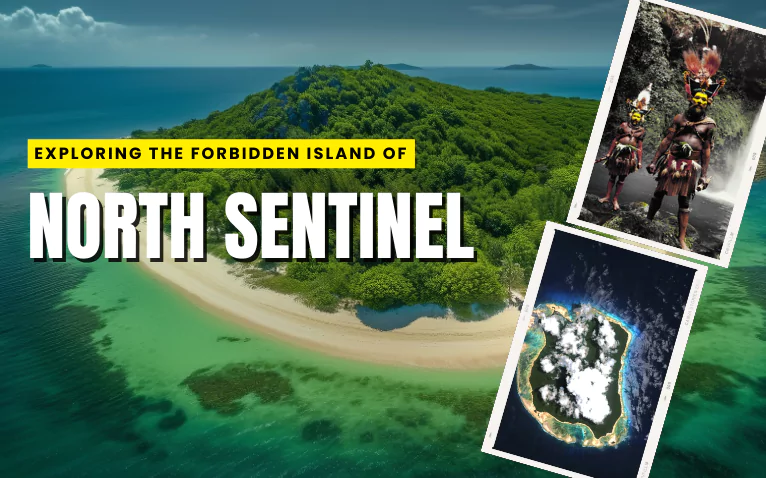Exploring our planet’s vast and diverse landscapes has long been a pursuit of humanity, driven by curiosity and the quest for knowledge. From scaling towering peaks to delving into the depths of oceans, we have uncovered many of Earth’s secrets. Yet, amidst this age of exploration, there remains one place that steadfastly defies discovery: North Sentinel Island, nestled in the Bay of Bengal. This small, remote island is not just a geographical curiosity but a testament to the resilience and mystery of the human spirit. Home to the Sentinelese, a tribe fiercely protective of their isolation, North Sentinel Island stands as a forbidden realm, barred to outsiders by natural barriers and strict governmental regulations. In this blog, we will uncover the enigma of North Sentinel Island—exploring its history, the unique culture of its inhabitants, the controversies surrounding its protection, and the enduring allure that continues to captivate the world’s imagination. Join me as we explore the secrets of one of Earth’s last frontiers of human isolation.
The Enigma of North Sentinel Island:
Belonging to the Andaman and Nicobar Islands chain, administered by India, North Sentinel Island is situated in the heart of the Bay of Bengal. It is a tiny, isolated landmass covering approximately 60 square kilometers (23 square miles). Despite its modest size, North Sentinel Island is significant in geographical mysteries due to its unique characteristics and the enigmatic tribe that calls it home.
Location and Physical Characteristics:
North Sentinel Island is approximately 50 kilometers (31 miles) west of Smith Island, another part of the Andaman archipelago. It is surrounded by treacherous coral reefs, which make approaching its shores perilous. The island is predominantly covered in dense tropical forests, shielding its interior from outside observation and exploration. The coastline is fringed with white sandy beaches that contrast starkly against the lush greenery of the interior.
Isolation and Unexplored Nature:
The primary reason for North Sentinel Island’s mysterious status is its extreme isolation. The Sentinelese tribe is believed to be the first human population to migrate out of Africa and is a direct descendant of the African tribe. They have inhabited the island for an estimated 60,000 years. They have consistently resisted contact with the outside world, displaying hostility towards any outsiders who attempt to approach their shores.
This isolation has contributed significantly to the island’s unexplored nature. Despite advancements in satellite imagery and aerial surveys, much of North Sentinel Island’s interior remains uncharted territory. The Sentinelese’s fierce protection of their homeland has thwarted attempts by anthropologists, researchers, and even government authorities to study their culture and way of life up close.
The Indian government recognizes the Sentinelese’s vulnerability to diseases from the outside world and has enforced strict protection measures, effectively banning all unauthorized visits to the island. This policy aims to preserve the Sentinelese people’s cultural integrity and unique habitat, ensuring that North Sentinel Island remains one of the last untouched frontiers of human civilization.
In the next section, we will go deeper into the enigmatic Sentinelese tribe—exploring their history, lifestyle, and the controversies surrounding their isolation.
The Sentinelese People:
The Sentinelese tribe, inhabitants of North Sentinel Island in the Bay of Bengal, are among the world’s most isolated and enigmatic groups. Their history spans millennia and is marked by an unwavering determination to remain disconnected from the outside world.
History of Isolation:
Throughout their extensive history on North Sentinel Island, they have maintained a steadfast isolation from modern civilization. This isolation has allowed them to develop a unique cultural identity and lifestyle largely untouched by external influences.
Despite occasional attempts by outsiders to establish contact, the Sentinelese have consistently rebuffed all advances. Their hostility towards outsiders is well-documented and serves as a clear message of their desire to protect their autonomy and traditional way of life.
Incidents of Aggression:
Numerous incidents illustrate the Sentinelese’s fierce determination to preserve their isolation. In 2004, after a devastating tsunami struck the Indian Ocean, a helicopter sent to check on the Sentinelese was met with a barrage of arrows, indicating their staunch resistance to outside interference. Similarly, in 2006, two fishermen who inadvertently strayed too close to the island were killed by the Sentinelese, underscoring the seriousness with which they defended their territory.
One of the most publicized incidents in 2018 shaped North Sentinel Island differently in the eyes of the world. It is when American missionary John Allen Chau ventured illegally onto the island to proselytize the Sentinelese. Despite knowing the risks and legal restrictions, Chau was killed by the tribe, further emphasizing their uncompromising stance on maintaining isolation.
These incidents highlight the Sentinelese’s hostility towards outsiders and their ability to repel intrusions into their territory effectively. Such actions underscore their commitment to safeguarding their culture and environment against perceived threats from the outside world.
In the next section, we will go deeper into the cultural and lifestyle aspects of the Sentinelese people, exploring their unique customs, traditions, and adaptation to their remote island environment.
Cultural and Lifestyle Insights:
The Sentinelese people, secluded on North Sentinel Island in the Bay of Bengal, maintain a distinctive culture shaped by their centuries-long isolation and resilience against outside influences. Exploring their way of life offers a glimpse into a world untouched by modernity.
Physical Appearance and Language:
Physically, the Sentinelese are described as having dark skin, short stature (around 165 centimeters or 5.5 feet on average), well-built frames, and shiny black hair. Their appearance reflects adaptations to their tropical island environment, where they have thrived as hunter-gatherers for millennia.
Their language remains unknown mainly and undeciphered by outsiders. Communication attempts have been limited to non-verbal gestures and occasional shouts in an unfamiliar tongue. This linguistic isolation further underscores their separation from the broader world.
Lifestyle and Subsistence:
The Sentinelese lead a nomadic lifestyle, moving within their territory in small groups. They rely predominantly on hunting, fishing, and gathering for sustenance. Hunting techniques involve bows, arrows, and spears crafted from materials found on the island, showcasing their adeptness in utilizing natural resources.
They supplement their diet with seafood, including fish, crabs, and mollusks, gathered from the island’s coastal waters. Evidence of their diet can be observed in the abundance of discarded shells and remnants of marine life near their settlements.
Despite their isolation, the Sentinelese demonstrate a remarkable ability to adapt to their environment. They construct temporary shelters using palm leaves and other local vegetation, showcasing their resourcefulness in utilizing natural materials for survival. While their dwellings may appear rudimentary, they provide adequate protection from the elements and serve as focal points for communal activities.
Tools and Technology:
The Sentinelese exhibit a primitive tool kit suited to their hunter-gatherer lifestyle. Apart from hunting weapons, they are known to craft canoes for fishing and transportation, although their exact construction techniques remain a mystery. Their mastery of fire remains uncertain, but they are observed using it, suggesting a basic understanding of its utility.
Socio-cultural Practices:
Little is known about the Sentinelese’s social structure and cultural practices. They live in small family units or clans, with hierarchical leadership likely based on age or experience. Ritualistic practices, dance, and music are speculated to play roles in communal activities, but detailed observations are limited due to their hostility towards outsiders. However, we believe education is yet to cross paths with them which actually promotes socio-cultural practices.
In essence, the Sentinelese culture embodies a unique adaptation to their isolated island environment, where traditional practices and self-sufficiency are paramount. Their way of life is a testament to human diversity and the resilience of Indigenous communities against external pressures.
In the following section, we will talk about the controversies surrounding efforts to study and protect the Sentinelese, examining the ethical considerations and policies that govern interactions with this secluded tribe.
Protection and Controversy:
North Sentinel Island and its inhabitants, the Sentinelese tribe, are under strict protection by the Indian government, which imposes stringent measures to preserve their isolation and cultural integrity.
Indian Government’s Protective Measures:
The Indian government has established a “no contact” policy regarding the Sentinelese people. This policy prohibits unauthorized access to the island, including tourism and research expeditions. The rationale behind these measures is twofold: firstly, to protect the Sentinelese from potential exposure to diseases for which they have no immunity, and secondly, to respect their wishes for isolation and autonomy.
Indian border patrol boats monitor the waters surrounding North Sentinel Island to deter unauthorized vessels from approaching. Any attempt to land on the island without permission is met with legal consequences, underlining the seriousness with which the protection of the Sentinelese is enforced.
Ethical Considerations: Isolation vs. Scientific Curiosity:
The debate surrounding North Sentinel Island revolves around balancing scientific curiosity with ethical considerations. On one hand, scientists and anthropologists are eager to study the Sentinelese to gain insights into their culture, language, and unique way of life. Such research could contribute significantly to understanding human diversity and cultural evolution.
On the other hand, any attempt to study or interact with the Sentinelese carries inherent risks. These include the potential introduction of diseases that could devastate the population, as demonstrated throughout history when indigenous peoples were exposed to pathogens against which they had no immunity.
Moreover, there are ethical implications regarding respecting the Sentinelese’s right to self-determination and autonomy. They have consistently demonstrated their desire to remain isolated, and any intrusion could disrupt their social dynamics, cultural practices, and overall way of life.
Ultimately, protecting the Sentinelese raises profound questions about the limits of scientific exploration and the responsibilities of researchers towards indigenous communities. It underscores the importance of approaching such delicate situations with sensitivity, respect, and a commitment to ethical guidelines.
The Legacy of Intrusion:
Throughout history, several documented attempts have been made to contact the Sentinelese, often with disastrous consequences. In the late 19th and early 20th centuries, British colonial officers and explorers failed to establish contact, resulting in hostility and violence from the Sentinelese.
One of the most infamous incidents occurred in 1880 when a British naval officer, Maurice Vidal Portman, led an expedition to North Sentinel Island. His efforts to “civilize” and study the Sentinelese led to the capture and removal of several islanders, who subsequently fell ill and died due to exposure to foreign diseases.
These historical intrusions underscore the resilience of the Sentinelese people in defending their isolation and autonomy. Despite facing repeated attempts at contact and interference, they have maintained their cultural traditions and survival strategies over thousands of years.
Today, the legacy of these intrusions informs current policies prioritizing the protection and preservation of the Sentinelese. The Indian government’s restrictive measures reflect a commitment to learning from past mistakes and safeguarding the Sentinelese from external threats, ensuring their continued existence in their ancestral homeland.
Conclusion:
North Sentinel Island and its inhabitants, the Sentinelese, stand as a poignant reminder of humanity’s diversity and the complexities of cultural preservation. Their steadfast determination to remain isolated challenges our perceptions of exploration and scientific inquiry in the modern age. While the allure of uncovering their secrets remains strong, it is crucial to approach such endeavors with respect, humility, and a deep appreciation for the ethical considerations at play.
As we continue to read more about the delicate balance between curiosity and respect for Indigenous autonomy, North Sentinel Island is a light of resilience and a testament to its inhabitants’ enduring spirit. Preserving their isolation protects the Sentinelese from external threats and upholds their right to self-determination and cultural identity in a rapidly changing world.







0 Comments